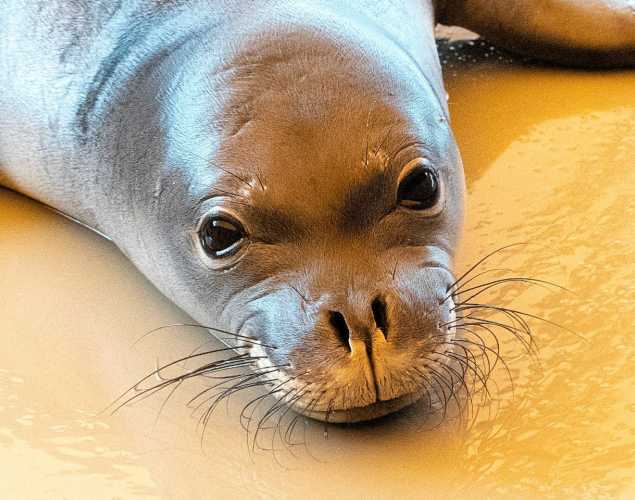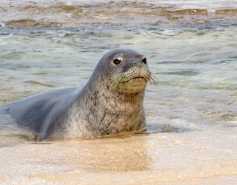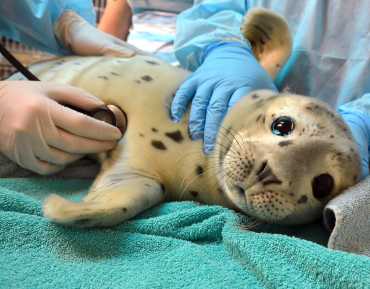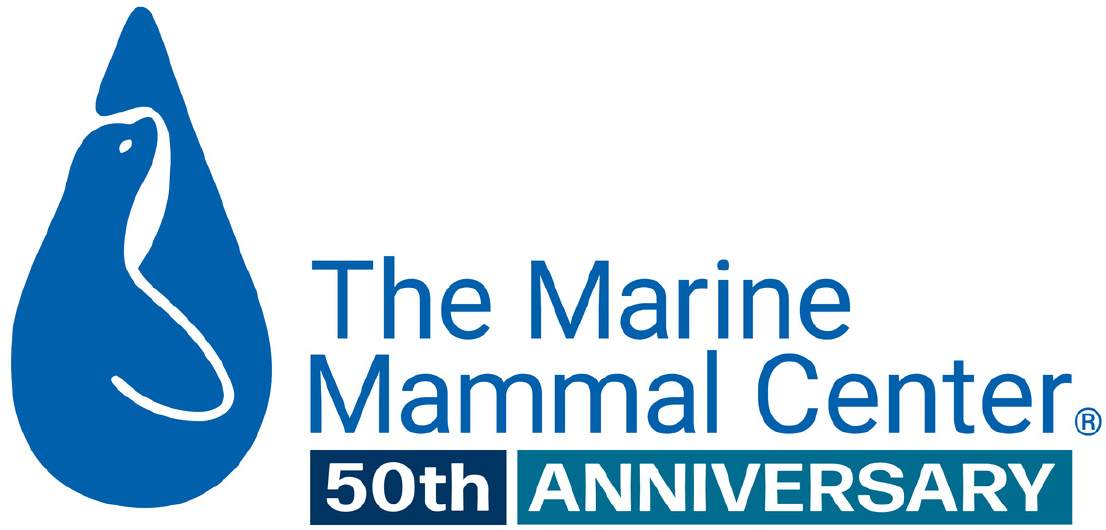
Starving Hawaiian Monk Seal Pup Rescued From Moloka‘i
- Species conservation
Unable to survive without his mother’s milk, the young male pup is now rehabilitating at Ke Kai Ola, our hospital for this endangered species.
A new Hawaiian monk seal patient recently arrived at Ke Kai Ola, our hospital and visitor center on the Big Island of Hawai‘i that is dedicated to this endangered species. The male pup was rescued on the remote Kalaupapa Peninsula on the island of Moloka‘i and brought to our hospital for care.
The pup switched to nursing from another monk seal mother who had been with her female pup since the end of May. Because of this switch, the pup’s nursing time was shortened, and he was prematurely weaned, resulting in low body weight. His small size and thin body condition quickly became a concern for wildlife experts. It was clear that intervention was critical to ensure the pup’s survival.
After consulting with the patient-residents and the Kalaupapa community, the decision was made to rescue the animal. The patient-residents suggested the name Sole (pronounced “SUH-lay”), a Samoan name that means “a young boy who is sent on an important journey for the high chief; a runner.”
“With only a few hundred monk seals living in the main Hawaiian Islands, the survival of each individual is critical to the recovery of the population,” says Dr. Claire Simeone, the Center’s Hospital Director at Ke Kai Ola.
Conservation takes a village. We are so grateful to our partners for their support in achieving our mission, and ensuring this pup made it safely to Ke Kai Ola.
Learn More About Hawaiian Monk Seals
Sign up to receive Hawaiian monk seal news, patient updates and more straight to your inbox.
{"image":"\/Animals\/Wild\/Hawaiian monk seal\/hawaiian-monk-seal-shutterstock.jpg","alt":"Hawaiian monk seal at the shoreline","label":"Pinnipeds","title":"Hawaiian Monk Seal","link_url":"\/animal-care\/learn-about-marine-mammals\/pinnipeds\/hawaiian-monk-seal","type":"page"}

{"image":"\/Animals\/Wild\/Hawaiian monk seal\/cropped-images\/HMS-wild-NOAA-4-832-3197-1474-1603733454.jpg","alt":"Two Hawaiian monk seals sleeping on the beach.","label":"Conservation","title":"Hawaiian Monk Seal Conservation","link_url":"\/science-conservation\/conservation\/hawaiian-monk-seal-conservation","type":"page"}

{"image":"\/Animals\/Patients\/Hawaiian monk seals\/2015\/hms-pearl-by-julie-steelman-c-the-marine-mammal-center-noaa-permit-18786.jpg","alt":"Hawaiian monk seal Pearl","title":"Understanding Endangered","link_url":"https:\/\/www.marinemammalcenter.org\/publications\/understanding-endangered","label":"Online Learning Resource","type":"publication"}

{"image":"\/Animals\/Patients\/Hawaiian monk seals\/2016\/hms-nihoole-5-photo-c-noaa-permit-16632.jpg","alt":"Hawaiian monk seal Niho'ole","title":"Aloha \u02bb\u0100ina","link_url":"https:\/\/www.marinemammalcenter.org\/publications\/aloha-aina","label":"Online Learning Resource","type":"publication"}

Veterinarians from our hospital, with the support of the United States Coast Guard, the National Park Service and the National Oceanic and Atmospheric Administration (NOAA), rescued the pup on Moloka‘i in mid-July. The United States Coast Guard provided a helicopter flight from Honolulu to Kalaupapa National Historical Park, and then on to Kona to safely transport the pup to Ke Kai Ola for medical treatment.
During Sole’s initial exam, Dr. Simeone noted that Sole was malnourished but otherwise stable. Dr. Simeone accompanied Sole during the journey to Ke Kai Ola and is providing supportive care at the hospital with the assistance of staff and volunteers.
Sole is currently receiving nutrition in the form of fish smoothies. As he grows stronger, he will transition to eating whole fish.
In order to give Sole the best chance of survival after release, human contact will be minimal during rehabilitation to reduce the risk of habituation. Specialized enrichment activities will help encourage development of natural behaviors and skills.
It is rare to rescue a monk seal from the main Hawaiian Islands, and this young pup is only the second patient from the main islands to receive care at Ke Kai Ola. The Marine Mammal Center has rehabilitated 23 monk seals since opening Ke Kai Ola in 2014, and the majority of these patients were rescued from the Northwestern Hawaiian Islands.
The Center is proud to partner with NOAA to support conservation efforts for the Hawaiian monk seal. Researchers estimate the current monk seal population to be about 1,400 animals, and about 30 percent of those monk seals are alive today directly due to conservation efforts led by NOAA and its partners.
Header image: Photo by Sheila Latta © The Marine Mammal Center, NOAA Permit #18786
Yes, I want to save a life!

Yes, I want to save a life!
You’ll be giving sick and injured animals the best possible care at the Center’s state-of-the-art hospital. With your gift today, you are giving a patient a second chance at life in the wild.
See Our Latest News
{"image":"\/Animals\/Patients\/Hawaiian monk seals\/2025\/cropped-images\/d-ru28release-exam-at-ke-kai-ola111025photo-by-giancarlo-rulli-c-the-marine-mammal-center-noaa-permit-24359-0-0-1270-992-1764620886.jpg","alt":"","title":"Bird Flu Vaccine Trial Offers Hope for Protecting Hawaiian Monk Seals","link_url":"https:\/\/www.marinemammalcenter.org\/news\/bird-flu-vaccine-trial-may-offer-hope-for-protecting-hawaiian-monk-seals","label":"News Update","date":"2025-12-01 08:13:00"}

Bird Flu Vaccine Trial Offers Hope for Protecting Hawaiian Monk Seals
December 1, 2025
Read More{"image":"\/Animals\/Patients\/Hawaiian monk seals\/2021\/hms-pp08-by-sheila-latta-c-the-marine-mammal-center-noaa-permit-18786.jpg","alt":"Hawaiian monk seal","title":"The New York Times: Inside the Bird-Flu Vaccine Trial for Monk Seals","link_url":"https:\/\/www.marinemammalcenter.org\/news\/the-new-york-times-inside-the-bird-flu-vaccine-trial-for-monk-seals","label":"In the News","date":"2025-12-01 01:00:00"}

The New York Times: Inside the Bird-Flu Vaccine Trial for Monk Seals
December 1, 2025
Read More{"image":"\/Animals\/Wild\/Sea otter\/so-wild-morro-bayphoto-c-brian-simuro-20.jpeg","alt":"Sea otter and pup","title":"Watch a Sea Otter Pup Reunite With Its Mother","link_url":"https:\/\/www.marinemammalcenter.org\/news\/watch-sea-otter-pup-reunite-with-its-mother","label":"News Update","date":"2025-11-14 10:35:41"}

{"image":"\/Animals\/Wild\/Sea otter\/sea-otter-photo-c-brian-simuro.jpeg","alt":"Sea otter","title":"AP News: Baby sea otter is reunited with mother in central California after dramatic rescue","link_url":"https:\/\/www.marinemammalcenter.org\/news\/ap-news-baby-sea-otter-is-reunited-with-mother-in-central-california-after-dramatic-rescue","label":"In the News","date":"2025-11-14 09:46:34"}

AP News: Baby sea otter is reunited with mother in central California after dramatic rescue
November 14, 2025
Read MoreHawaiian Monk Seal
